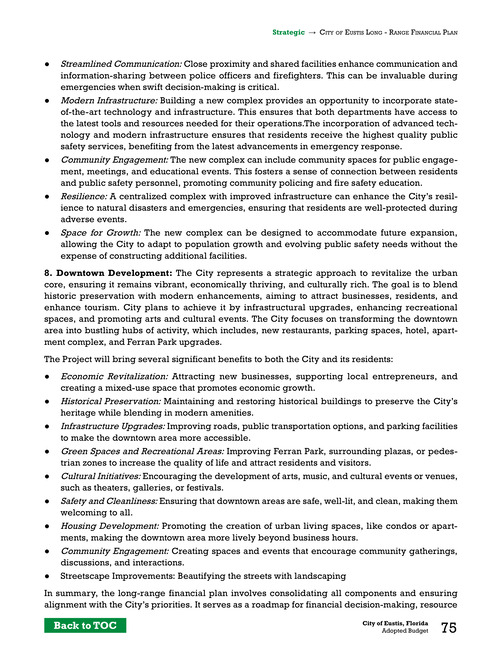Adopted Budget Book FY 23-24 Final with TOC links - Flipbook - Page 76

Strategic → CiTy of eusTis long - range finanCial Plan
●
●
●
●
●
●
●
●
Infrastructure Investment: Impact fees are typically earmarked for specific purposes, such
as roads, utilities, parks, or public facilities. The study helps identify the infrastructure needs
arising from population growth and new developments, ensuring that the city can accommodate
its expanding population effectively.
Economic Analysis: The study often includes an economic analysis to assess the potential impact
of impact fees on development activity. This analysis considers factors like housing affordability,
economic competitiveness, and market dynamics.
Public Input: Community engagement is a crucial component of the study process. Public hearings, meetings, and feedback mechanisms allow residents, developers, and stakeholders to
express their views and concerns. This input can shape the study’s recommendations.
Planning for Growth: An impact fees study is inherently forward-looking. It takes into account
projected growth patterns and population increases to ensure that infrastructure is in place to
accommodate future needs.
Financial Sustainability: By accurately assessing the costs associated with growth, the study
contributes to the financial sustainability of the city. It prevents the burden of infrastructure
costs from falling solely on existing residents and taxpayers.
Infrastructure Maintenance: Impact fees can also be used to maintain and rehabilitate existing
infrastructure, not just build new assets. This is critical for ensuring that the city’s existing
services remain in good condition.
Long-Term Planning: Impact fees studies are often part of the city’s long-term planning efforts.
They help the city prepare for growth in an organized and sustainable manner.
Economic Development: Balanced and reasonable impact fees can encourage responsible and
sustainable development, which can in turn attract businesses and promote economic growth.
The City’s impact fees study is a multifaceted process with significant implications for growth, infrastructure investment, and financial sustainability. When conducted comprehensively and transparently, it serves as a valuable tool for both city officials and the community as they plan for and
manage the impacts of growth and development.
7. Public Safety Complex Construction: Constructing a new Public Safety Complex, which
combines the Police and Fire Departments into a single centralized building, in FY 27-28 with a
budget of $13,000,000 necessitates securing financing. This project falls under the Safe Community
Priority, specifically Goal #1, Strategic Priority 5 of the City’s Strategic Plan - Reduce Solve and
Prevent Crime.
The Project will bring several significant benefits to both the City and its residents:
●
●
●
74
Enhanced Public Safety: The consolidation of the Police and Fire Departments in a single
complex fosters collaboration and coordination between these critical emergency response
units. This synergy allows for faster response times and more effective management of emergencies, ultimately improving public safety citywide.
Cost Efficiency: Operating and maintaining separate facilities for the Police and Fire
Departments can be expensive. The new complex streamlines administrative and operational
functions, leading to cost savings in the long run. These cost efficiencies can help the City allocate resources to other important municipal initiatives.
Improved Resource Utilization: A centralized complex enables better resource utilization, such
as shared training facilities, meeting spaces, and equipment storage. This maximizes the utility
of existing assets and reduces redundant investments.
City of Eustis, Florida
Adopted Budget
Back to TOC












